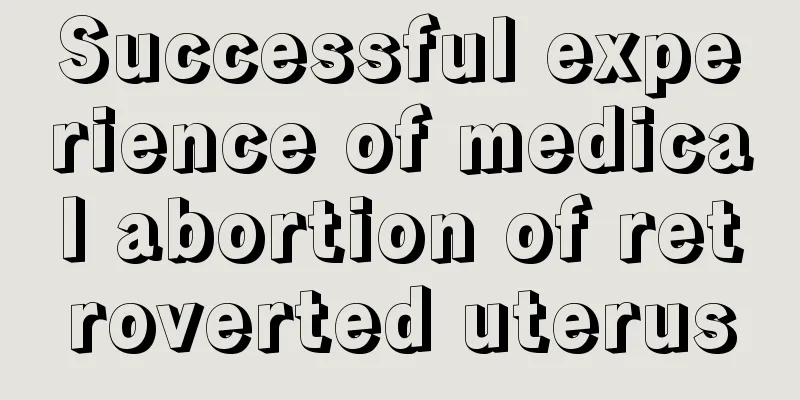How long does it take for lochia to be discharged after delivery?

|
Mothers have normal physiological needs for lochia after giving birth. It is different from the 3-5 days of women's menstrual period every month, and its smell, color and duration are different. For first-time mothers, lochia is often mistaken for menstruation because of lack of understanding. In the early stages of postpartum lochia, it is considered a physical problem before it ends. Convenient postpartum conditioning for first-time mothers. Below is some knowledge about postpartum lochia. It is important to know how long it takes for a mother to have lochia discharged! After delivery, the uterine decidua, especially the decidua at the embryonic appendage, falls off, and tissues such as blood and necrotic decidua are discharged through the vagina, which is called lochia. How long it takes for postpartum lochia to be discharged varies from person to person, ranging from a dozen days to six weeks, with an average of about 21 days. If the time exceeds the above, pregnant women will be in a state of incomplete lochia discharge, which is what we often call unclean lochia, unclean lochia, continuous lochia after delivery, continuous lochia in parturients, and continuous lochia in parturients. So why is it that postpartum lochia cannot be discharged completely? In fact, it is all caused by intrauterine infection after childbirth, residual tissue, and weak uterine contractions during labor. Let's take a look at the analysis: 1. Tissue residues cause the mother's lochia to be unable to be discharged cleanly The residual tissue is due to reasons such as maternal uterine malformation, uterine fibroids, etc., and also due to the surgeon's lack of technical skills, which leads to the failure to completely eliminate the pregnancy tissue, resulting in residual tissue in the uterine cavity. In addition to the problem of unclean lochia, there are also problems such as bleeding that is sometimes more and sometimes less, with blood clots inside, and accompanied by intermittent abdominal pain. 2. Intrauterine infection causes the mother's lochia to be unable to be discharged cleanly Intrauterine infection is caused by pregnant women taking a sitz bath after giving birth, or using unclean sanitary napkins, or having sex before the baby is one month old. It can also be caused by untimely disinfection by surgical operators. In addition to the postpartum lochia not being discharged cleanly and having a strange smell, there will also be symptoms of abdominal tenderness and fever. 3. Weak uterine contractions cause the mother's lochia to be unable to be discharged completely The problem of unclean lochia is partly due to weak uterine contractions, inability to rest well after giving birth, or weak physical constitution, or long labor time, which leads to blood and qi depletion. The above is the common knowledge about postpartum lochia that I want to share today. Even if the lochia of the parturient cannot be discharged completely, mothers do not need to worry too much. As long as they rest well after giving birth and do a good job of postpartum conditioning according to the doctor's instructions, the lochia of the parturient will be discharged completely in a dozen days! |
<<: Is it normal to have menstruation in the first month after giving birth?
>>: Is light green lochia normal?
Recommend
What should I pay attention to after laparoscopic surgery?
Patients who have undergone hysteroscopy and lapa...
What are the causes of endometriosis?
In daily life, many women are always troubled by ...
Not pregnant on ovulation day
Some people will specifically choose to have sex ...
Women suddenly have severe back pain
Low back pain mainly refers to the pain felt in t...
What causes breast hyperplasia?
Currently, more and more young women are sufferin...
When is the birthday of ice hockey? What is the basis for winning an ice hockey game?
Ice hockey is a team sport usually played on indo...
What is the reason for watery and bloody leucorrhea?
Watery leucorrhea with streaks of blood is a sign...
The private part has a fleshy lump that does not hurt or itch
What is the reason for the growth of lumps in the...
Feeling dizzy and having pain in the neck? Don't ignore it, it may not be cervical spondylosis
Mr. Li is a 45-year-old senior corporate manager....
Normal range of amniotic fluid index at 31 weeks of pregnancy
Pregnant women should understand the amniotic flu...
What should you pay attention to when eating hot pot? How to prevent diarrhea after eating hot pot?
Eating hot pot can sometimes cause stomach upset....
Why does the TV flicker? Why does the TV have no signal?
As long as it is an electronic network product, v...
My period is delayed for ten days and I have a lot of vaginal discharge
For women, accurate menstrual periods are very im...
What are the symptoms of liver fire in women?
The liver is a very important detoxification orga...
What should pregnant women eat to regulate sleep? The following three kinds of food will tell you
It is very important for mothers to get enough sl...









